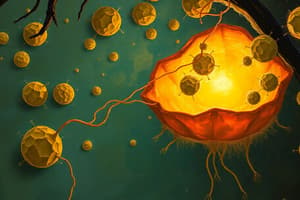Podcast
Questions and Answers
How do most viruses and viroids invade host plants?
How do most viruses and viroids invade host plants?
- Move from cell to cell (correct)
- Replicate in plant seeds
- Grow between the cuticle and the epidermis
- Invade the xylem vessels
Which method is NOT a common way for bacteria to enter host plants?
Which method is NOT a common way for bacteria to enter host plants?
- Natural openings
- Wounds
- Mechanical entry
- Phloem sieve tubes (correct)
How do most nematodes gain entry into host plants?
How do most nematodes gain entry into host plants?
- Invading the xylem vessels
- By moving from cell to cell
- Using stylets (correct)
- Growing on the surface
What is a common method for fungi and Oomycetes to enter host plants?
What is a common method for fungi and Oomycetes to enter host plants?
How do bacteria and mollicutes typically reproduce within host plants?
How do bacteria and mollicutes typically reproduce within host plants?
What is a common method for plant pathogens to move from plant to plant without a vector?
What is a common method for plant pathogens to move from plant to plant without a vector?
Which of the following is NOT a stage in the disease cycle of a pathogen?
Which of the following is NOT a stage in the disease cycle of a pathogen?
Which of the following best describes the relationship between a parasite and its host?
Which of the following best describes the relationship between a parasite and its host?
How do obligate parasites differ from facultative parasites in terms of their ability to infect living and dead tissue?
How do obligate parasites differ from facultative parasites in terms of their ability to infect living and dead tissue?
Which of the following is a characteristic of pathogenicity?
Which of the following is a characteristic of pathogenicity?
How do viruses and viroids differ in terms of their transmission and infection of plant cells?
How do viruses and viroids differ in terms of their transmission and infection of plant cells?
Which of the following is the primary method by which bacteria and fungi enter and infect plant cells?
Which of the following is the primary method by which bacteria and fungi enter and infect plant cells?
What term describes the series of events that occur during the pathogenic relationship of a pathogen and host leading to disease?
What term describes the series of events that occur during the pathogenic relationship of a pathogen and host leading to disease?
Which of the following is NOT a step in the disease development process for infectious diseases?
Which of the following is NOT a step in the disease development process for infectious diseases?
What is the term for the period between pathogen penetration and the first appearance of symptoms in a plant?
What is the term for the period between pathogen penetration and the first appearance of symptoms in a plant?
In disease development, how do pathogens primarily enter plants for infection?
In disease development, how do pathogens primarily enter plants for infection?
Which of the following is characteristic of the symptom observation phase in disease development?
Which of the following is characteristic of the symptom observation phase in disease development?
Flashcards are hidden until you start studying




